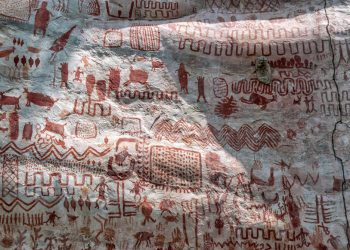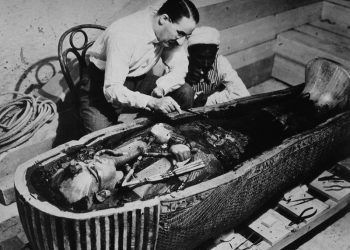Throughout history, our planet has undergone dramatic environmental changes, from extreme temperature shifts and changes in atmospheric composition to continental drift and major impact events. Throughout Earth’s history, some of the strangest animals that ever lived have called this planet our home.
As the earth evolves, its inhabitants adapt to survive the new environment. Our planet’s dynamic nature has led to some bizarre evolutionary adaptations, many of which are still exhibited by extant species.
But some of the most unusual features were possessed by primitive animals that are now extinct. In this article, we journey through the ages as we explore ten of these weirdly wonderful prehistoric animals and their peculiar traits.
Some of the Strangest Animals that Ever Lived
A Leggy Worm
The Hallucigenia sparsa was a 508-million-year-old lobopodian worm that inhabited marine environments. It was an early ancestor of the velvet worm. The minuscule monster was less than an inch long, and its tube-like body was thinner than a hair. For over a century, scientists had been studying Hallucigenia fossils from the Burgess Shale in the quest to understand this alien-like worm.
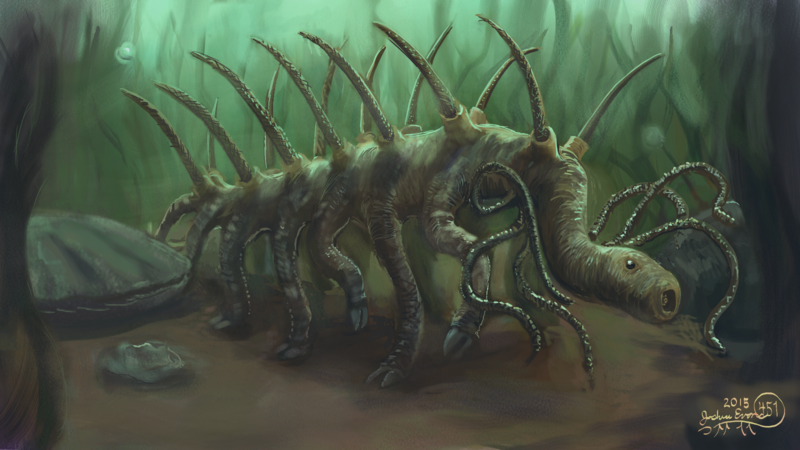
But the fossils were missing an important part of the animal, and for a long time, it was a literal question of heads or tails. As it turns out, they were examining the fossils upside down. Finally, in 2015, the missing piece of the puzzle was unearthed, and for the first time, revealed the organism’s head, complete with a grinning face, a tiny pair of eyes, and a ring of teeth. It had a circular mouth, and a peek inside its throat revealed another row of teeth that reached down to its gut. But the oddities don’t end there. The whimsical worm also had spines on its back and seven rows of legs with clawed feet. The discovery was a scientific breakthrough, providing researchers with new information about Ecdysozoan animals. It also provides key insights into life during this period.
A Tiny Five-Eyed Predator
Opabinia regalis was a strange, soft-bodied arthropod-type animal that lived around 505 million years ago. It was a two-inch-long carnivore that hunted along the ocean floor. It had a segmented body, gills, a clawed proboscis for feeding, a fan-shaped tail, and five bulging eyes attached to short stalks on the top of its head. The Opabinia was unlike any other animal. It is often regarded an arthropod, but scientists believe it may have been a relative of the equally odd tardigrades. It is still unclear exactly what these curious critters were or where they fit along evolutionary lines.
A Jumbo Shrimp
Aegirocassis benmoulae is one of nature’s great oxymorons. You don’t typically associate a shrimp with a 7-foot-long sea monster. But this is precisely what a fossil collector discovered in the southeast of Morocco, and he is now the namesake of the giant arthropod. The shrimp-like animal had modified legs, gills on its back, two sets of swimming flaps, and filter-feeding apparatus for a diet of plankton.
Aegirocassis swam the oceans around 480 million years ago and was one of the largest animals of its time. Another astounding arthropod was the Jaekelopterus – a giant freshwater scorpion of the Devonian era.
There are several theories surrounding the evolution of mega arthropods. Some scientists believe they evolved to keep up with larger prey or to compete with other vertebrates.
The First Walking Fish
We cannot talk about evolutionary milestones without mention of one of the earliest species to bridge the gap between fish and amphibians. Tiktaalik roseae was a species of lobe-finned fish of the Devonian period. The “fishapods” inhabited freshwater environments circa 375 million years ago.
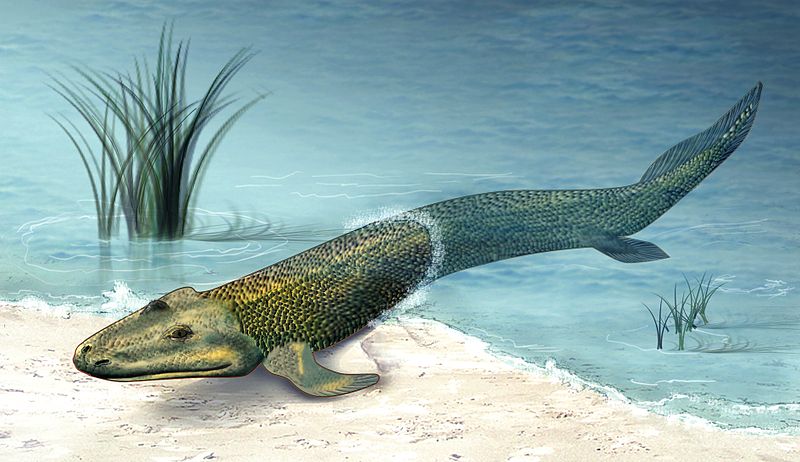
Pristine fossils of this ancient fish were found in Canada in 2004. The Tiktaalik had gills and scales like any good fish should. But it also had a neck, a flat triangular head, primitive lungs, and specialized fins with wrist-like adaptations and finger-like rays, enabling it to prop itself up in shallow waters. As bizarre as that sounds, this remarkable sarcopterygian was one of the pioneers for species making the transition from water to land.
A Monstrous Millipede
If you’re wary of creepy crawlies, you can take comfort in knowing that mega arthropods like this one no longer exist. Arthropleura armata was among the largest arthropods that lived on land. It existed between 290 and 320 million years ago during the carboniferous period when oxygen levels were at a whopping 35% accounting for its humongous size. Another arthropod that benefited from this phenomenon was the Meganeuropsis – a 17-inch-long griffin fly and the largest known insect.
Arthropleura was believed to reach lengths of up to six feet. The disturbing diplopod had a flattened body shape with thirty plated segments. Contrary to prior theories of a predatory lifestyle, Arthropleura was a herbivore or predominantly so. It inhabited coal swamps in Europe and North America and fed on fern-like plants and other swamp vegetation, leaving behind twenty-inch-wide tracks. Their walking trails were found in Scotland, Canada, and the United States.
The impressive traits of Arthropleura Amata likely afforded it a good degree of protection as it was believed to enjoy a life free from predators as far as we know. Arthropleura became extinct at the onset of the Permian period, which was characterized by a drier environment than what this ancient arthropod was accustomed to.
A Saw Fish
The Helicoprions comprised three species of prehistoric fish that lived 270 million years ago in the Permian period. Their fossils were found across the globe in parts of Asia, Europe, and North America. The shark-like fish had an outlandish tooth whorl attached to the lower jaw, leaving a wide-open gape, exposing this killer weapon as they hunted.
https://www.youtube.com/watch?v=-HZtnhAfQfA
The impressive structure was around 20 inches long with up to 150 teeth and functioned as a serrated slicing mechanism. It is unclear what these spine-chilling predators ate, but theories suggest they preyed on soft-bodied animals. One thing’s for sure – whatever found itself in these jaws was met with a gruesome ending.
A Feathered Reptile
During the 1960s, a fossil was discovered in Kazakhstan that perplexed evolutionary biologists and spurred debate among the scientific community. The fossil was of a creature that existed between 230 and 240 million years ago.

Longisquama insignis was a six-inch reptile with long, plume-like structures growing along its back. And that’s where the confusion lies. Feathers, as we know, are associated with birds, which are widely believed to have evolved from dinosaurs. But Longisquama existed just before the earliest dinosaurs roamed the earth and way before the first feathered dinosaurs evolved. So how did they come to have these feathers?
The question remains a mystery. Some scientists believe that the feather-like appendages were, in fact, scaly protrusions and not feathers. Others didn’t believe them to be part of the animal at all, but rather the leaves of a plant that was fossilized with it. Either way, this petite diapsid has our attention.
Urvogel – The Earliest Bird
Archaeopteryx lithographica was one of the first dino birds. It lived around 150 million years ago in the Jurassic period. The word Urvogel is German for “first bird.” Although fossils from older bird-like dinosaurs were found, Archaeopteryx was the first species discovered to exhibit feathers and was thus an important transition fossil between dinosaurs and birds.

Despite its small size – roughly the size of a crow, the Archaeopteryx was a spectacular creature. True to any transition animal, it was characterized by a unique blend of features, sharing traits with avians as well as therapod dinosaurs. It had the feathers and wings of a bird and the teeth and tail of a dinosaur. Findings also reflect a complex plumage coloration made up of light and dark feathers. Archaeopteryx was capable of flight and had a similar flight pattern to modern-day pheasants. They may not have been true birds or strong flyers, but the discovery of Archaeopteryx revolutionized our understanding of the origin of birds.
Strangest Animals that Ever Lived: A Miniature Mammoth
The mammoths we know of are massive prehistoric elephant-like beasts. In fact, the word mammoth is often used as an adjective as it is synonymous with very large things. That’s what makes the Cretan dwarf mammoth (Mammuthus criticus) so extraordinary. As the name suggests, this pint-sized proboscid inhabited the Greek island of Crete in the Mediterranean around 3.5 million years ago.
They were about 3 feet tall at shoulder height and weighed around 680 pounds – roughly the size of a large pig, making them the smallest mammoths to have existed. Their diminutive size can be attributed to a phenomenon known as island dwarfism, whereby a species shrinks over time due to the limited number of resources available in isolated environments.
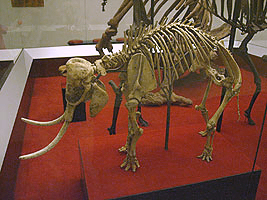
A Giant Armadillo
The Doedicurus clavicaudatus was one of the largest members of the armadillo family, Chlamyphoridae. At around 13-feet long, 5-feet tall, and a hefty 3000 pounds, it was about the size of a small car. It had a robust, dome-shaped body and a plated carapace – much like its armored relatives. But unlike the armadillos, the Doedicurus had a spiky tail club that resembled a flail and was used in defense against potential predators.
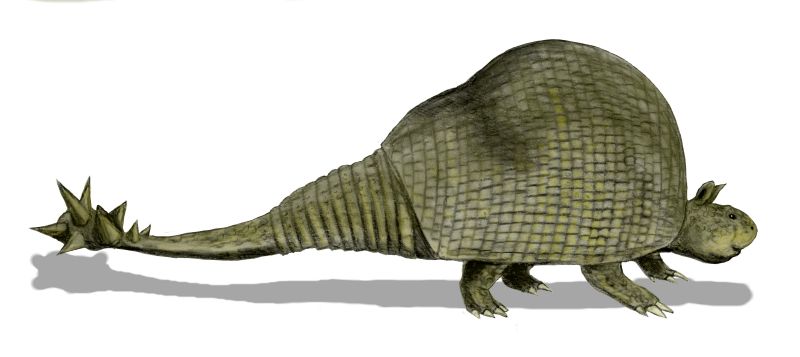
You may be wondering what kind of hellish beast could have successfully hunted a massive thumping monstrosity with a weapon for a tail. Fossils show that the saber-toothed cat, or possibly even a jaguar, may have been a worthy contender. We can only imagine those confrontations. Doedicurus inhabited parts of South America and went extinct as recently as 10 000 years ago. This means that modern humans would have encountered these ginormous mammals.
Primitive earth boasted a plethora of wondrous creatures. None of these otherworldly animals are around today, but their biological imprints left crucial tracks throughout time. Their discoveries have led to a deeper understanding of life on earth and helped us piece together evolutionary lineages. Moreover, they feed our imaginations and inspire us to learn about the fascinating and mysterious primordial world.
Join the discussion and participate in awesome giveaways in our mobile Telegram group. Join Curiosmos on Telegram Today. t.me/Curiosmos
Sources:
- BBC. (2015, June 25). Face of bizarre sea creature Hallucigenia revealed
- Yale News. (2015, March 11). Giant sea creature hints at early arthropod evolution.
- Science Daily. (2014, January, 13). Discovery of new Tiktaalik roseae fossils reveals key link in evolution of hind limbs.
- New Scientist. (2012, March 21). Reptile grew feather-like structures before dinosaurs.
- BU Blog. (2012, September 24). Archaeopteryx – First Bird or Transitional Species?
- BBC. (2012, May 9). Smallest mammoths found on Crete.
- Rheuters. (2016, Feb 23). Ancient armoured mammal from Argentina was a huge armadillo.







